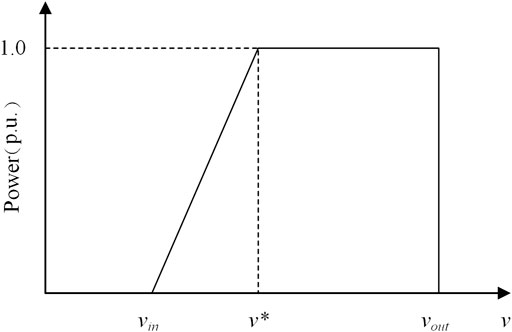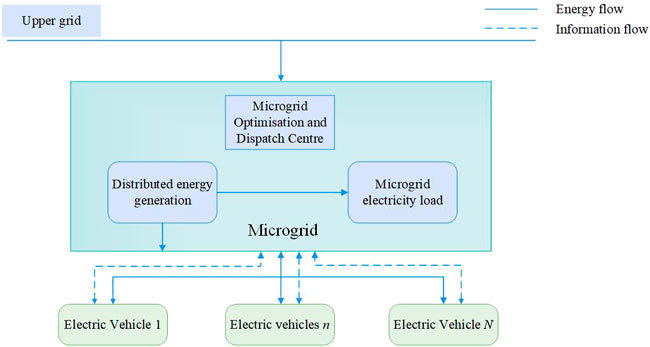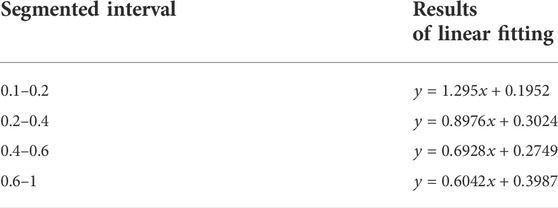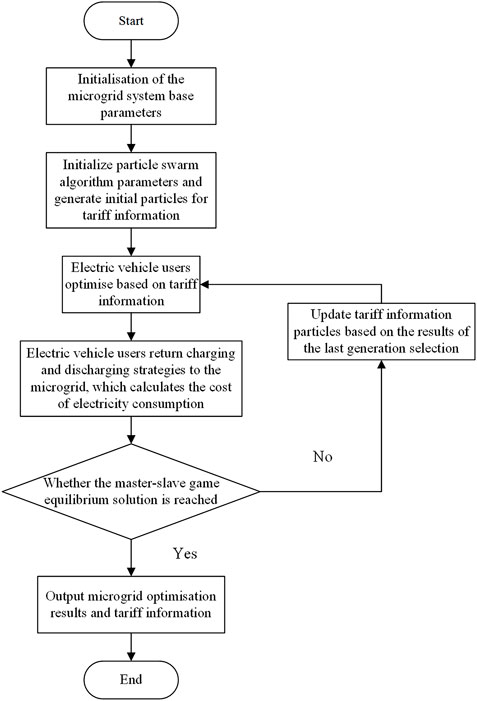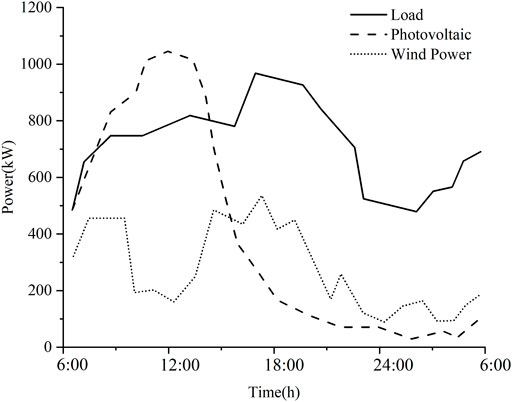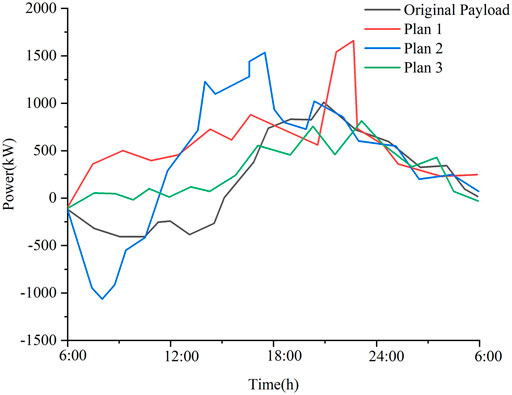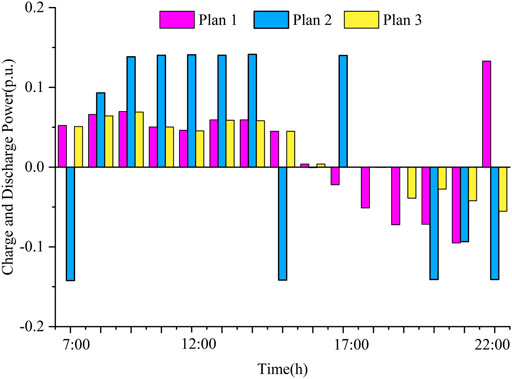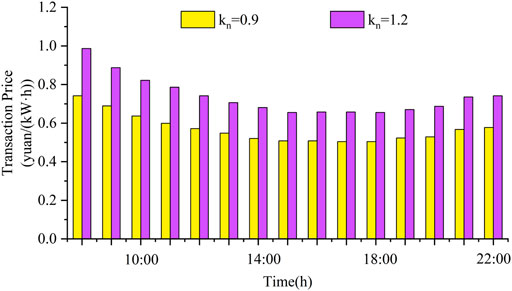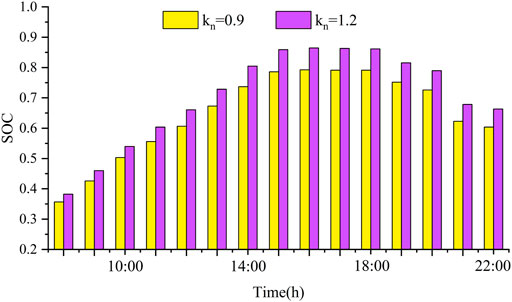- 1Shenyang Institute of Engineering, Shenyang, China
- 2Key Laboratory of Regional Multi-energy System Integration and Control of Liaoning Province, Shenyang Institute of Engineering, Shenyang, China
- 3State Grid Chaoyang Power Supply Company, Chaoyang, China
The development of both microgrids and electric vehicles has become an important part of the current energy scenario. Useful complementary advantages can be formed between electric vehicles and microgrids, the consumers of which can utilize renewable energy and narrow the peak–valley differences of the net load curve while ensuring their own pecuniary interests. Based on the idea of the Stackelberg game, an optimal dispatch model of a microgrid with electric vehicles is proposed herein, where the benefits of the state of charge are taken into account. In the upper layer of the model, the charging and discharging behaviors of electric vehicles are guided by the goal of minimizing the operating cost of the microgrid. In the lower layer of the model, electric vehicle users adjust the charging and discharging strategies with the goal of maximizing their individual interests. The study results demonstrate that the proposed model not only reflects the benefits of both the master and slave but also reduces the peak–valley differences of the microgrid load. Further, the charging and discharging times of electric vehicles are reduced, and their state of charge is maintained at a high level.
Introduction
Microgrids have rapidly gained popularity and are being increasingly applied in recent years. There is good complementarity between the energy structure characteristics of microgrids using renewable energy and the use of electric vehicles. The ability of an electric vehicle to gain access to a microgrid will become one of the important considerations in microgrid and electric vehicle applications (Cecati et al., 2011; Dagdougui et al., 2019; Ma et al., 2021a). However, because of the randomness of renewable energy availability and electric vehicle charging behaviors, there are some uncertain factors in the microgrid dispatch optimization process. Therefore, research on microgrid dispatching related to electric vehicles must consider the corresponding stochastic dispatch optimization method and establish energy dispatch models for uncertain environments to improve the economy and stability of the microgrid dispatch optimization scheme (Sortomme et al., 2011; Li Z. et al., 2019; Teng et al., 2020; Ma et al., 2021b). At the same time, in the interactions between microgrids and electric vehicle users, different interests are expressed by both sides. Electric vehicle users hope to participate in microgrid dispatch without affecting their normal use to obtain maximal benefits. Microgrid users hope to reduce their electricity costs and improve the operating environments through the charging and discharging behaviors of electric vehicles (Fu et al., 2021; Ma et al., 2021c). Although the interests and benefit objectives of the two sides are different, there are certain conflicts of interest; this can result either in a win-win situation for both sides through cooperation or in competition between both sides to maximize their own profits. Therefore, when studying the interaction behaviors between microgrids and electric vehicle users, it is very important to choose a reasonable strategy that conforms to the actual behavioral characteristics of both parties and to establish an optimal scheduling model that meets the interests of both parties (Tushar et al., 2012; Yang et al., 2019; Ma et al., 2021d).
At present, neither the grid operators nor electric vehicle users engage in organized orderly charging of electric vehicles, so disorderly charging is still the dominant behavior (Gong and Li, 2021; Zheng and Yao, 2021). However, the influence of the disorderly charging of electric vehicles on the power grid cannot be ignored (Wolsink, 2012; Kakran and Chanana, 2018; Muhtadi et al., 2021). The charging conditions of electric vehicles are analyzed from the perspectives of energy consumption and use. The charging load of an electric vehicle increases the running burden on the transmission and distribution networks, and the increase in line load rate increases equipment losses. Generally speaking, the influence of electric vehicles on the power grid can be examined from three aspects, namely power grid reliability, power quality, and operational economy (Wang et al., 2018; Ma et al., 2019; Zhu et al., 2019; Zhang et al., 2021). When considering the spatial distribution of electric vehicles as the research objective, the charging locations of the vehicles must be guided in an orderly manner. The utilization rates of the charging facilities and electricity balance rates of different regions can be improved by preventing high charging loads in certain regions (Richardson et al., 2012; Shafiee et al., 2013; Li F. et al., 2019). Temporally, the goal involves reducing the load fluctuation variance and peak–valley differences; spatially, the goal is minimizing the charging cost of the user. At the same time, the scheduling of the charging load has been considered from the perspectives of both time and space (Wan et al., 2018; Yang et al., 2020; Wang et al., 2021). The abovementioned works examine only the charging behavior control of electric vehicle users; therefore, electric vehicles are regarded as electrical equipment that can only reduce and translate loads, and the control methods and achieved effects are not flexible enough as they usually achieve only the load filling function.
To address the spatiotemporal uncertainties of electric vehicle operation, a robust optimal dispatch model has been constructed by combining a data-driven algorithm with the risk coefficient method (Wei et al., 2017). The intraday real-time scheduling of electric vehicle charging and discharging has been realized using deep learning without generation selection calculation (Huang et al., 2017). The imbalance rate of the microgrid is calculated from the real-time data of renewable energy output and load. Then, the reasonable electricity price information based on the imbalance rate is released to guide the charging and discharging behaviors of electric vehicles and to realize coordinated operations of electric vehicles and renewable energy in the microgrid (Wu et al., 2017). However, the aforementioned studies are concerned with centralized management of electric vehicles in the microgrid without considering user independence; users cannot respond to the demand side depending on their situation, and the dispatch center must perform extensive data processing and calculations.
The dispatching problem of connecting electric vehicles to the microgrid is compared with the traditional scheduling problem, and the randomness of both renewable energy and load in the microgrid is considered in this study. By analyzing the benefits of the microgrid and electric vehicle user participation in dispatching based on the master–slave game theory, an optimal dispatch strategy is proposed for the microgrid with electric vehicles considering the state of charge (SOC). Further, a microgrid scheduling model with electric vehicles is established based on the master–slave theory, and the existence of the equilibrium solution of the benefit function is proven. Finally, the model is solved to obtain the real-time electricity pricing scheme for optimal scheduling.
Distributed output modeling of the microgrid considering prediction error
Photovoltaic and wind powers are two of the commonly used distributed power sources in a microgrid. However, as the outputs of both photovoltaic and wind power generation are greatly affected by environmental conditions, there may be errors in their power forecast. The influences of these errors increase with the increasing penetration of the two renewable energy sources. Therefore, the optimal dispatch of the microgrid must be modeled to improve the reliability of the dispatch results.
Photovoltaic output model considering prediction error
The output from photovoltaic power generation is not only affected by environmental factors but also related to the characteristics of the system components, such as the photoelectric conversion efficiencies of materials and series–parallel modes of the components. However, these factors do not obviously influence the output forecast of the photovoltaic system. The main factors affecting the photovoltaic output prediction results are random and uncontrollable natural environmental conditions, such as solar light intensity, cloud layer position and thickness, and weather conditions. The output power of the photovoltaic power generation equipment can be represented by (1)
where
where
Once the probability distribution of the prediction error is obtained, the predicted value of the photovoltaic equipment output can be expressed as a superposition of the predicted value and prediction error:
where
Wind power output model considering prediction error
Similar to the factors affecting the output predictions of photovoltaic equipment, the outputs of wind power equipment are affected mainly by the wind speed. The relationship between the unit output and wind speed can be expressed by (4)
where
From (4), it is observed that when the actual wind speed is less than the cut-in or greater than the cut-out wind speeds, the output of the equipment is 0. When the actual wind speed is between the cut-in and cut-out wind speeds, the output of the wind power equipment is directly proportional to the wind speed as shown in Figure 1.
Similarly, from theoretical analysis of the probability and statistics combined with historical data, the prediction error of the wind power output can be described by a normal distribution with a mean value of 0. Given that
where
The wind power output forecast before today can also be expressed as a superposition of the forecast value and forecast error:
where
Load model considering forecasting error
Past research shows that the load power fluctuation can be represented as a normal distribution with the predicted value as the average. Thus, the actual load value can be decomposed into the predicted load and predicted error values that are normally distributed. The actual output expression of the load and probability density expression of the prediction error are shown in (7, 8):
where
Net load of the microgrid
In the established model, the microgrid itself is affected by three variables: wind power, photovoltaic output, and load. In this study, the net load is used to represent the algebraic sum of these three variables:
where
Optimal dispatch of the microgrid with electric vehicles considering the state of charge
Dispatch structure of the microgrid when electric vehicles are connected
In the optimal dispatch of a microgrid with electric vehicles under the Stackelberg game structure, the electric vehicles and microgrid not only maintain electrical energy interactions during the dispatch period but also sustain information exchange during the scheduling plan. The electric vehicles considered in this study are the working vehicles and private cars of the microgrid users. The electric vehicle users in the microgrid reported parameters such as the access times and battery information of the electric vehicles to the microgrid dispatch center a few days prior. Based on the information reported by the users, forecast results are generated for the new energy outputs and electricity loads in the microgrid as well as the purchase and sale prices of its superior power grid. Then, the charging and discharging prices are released to the electric vehicle users to obtain responses. Next, based on the user responses, the electricity price and amounts of electricity purchased and sold by the superior power grid are adjusted. To improve the consumption rate of new energy generation and the economy of electricity consumption, unified dispatch of the electrical energy in the microgrid is completed. Figure 2 shows a schematic of the microgrid dispatch structure when electric vehicles are connected.
Optimal dispatch model of the microgrid based on the Stackelberg game
Under the framework of the master–slave game theory, the microgrid as the leader has the initiative in the game, with priority being assigned to the electric vehicle users to release the electricity pricing scheme. As the followers, the electric vehicle users respond to the microgrid dispatch by comprehensively considering their own SOC and the economic benefits derived from electrical energy exchange with the microgrid; these responses are returned to the charging and discharging power scheme. The electricity pricing scheme of the microgrid is then adjusted according to the user return strategy. Finally, the Nash equilibrium scheme of the Stackelberg game is obtained.
By issuing an appropriate electricity pricing scheme, the electric vehicle users can be guided to provide certain charge and discharge powers within an appropriate time period. This can improve the consumption rate of new energy output in the microgrid while reducing the cost of electricity. The electricity cost objective function of the microgrid is as follows:
where
a) Power balance constraint
This constraint ensures that the electric vehicles absorb the wind and light outputs from the microgrid maximally and allow full utilization of the energy storage characteristics of batteries. The microgrid structure proposed in this study does not contain any energy storage equipment, and any electricity shortage or excess electricity in the microgrid is traded directly with the superior grid.
where
b) Electric vehicle trading price constraint
where
c) Interactive power constraint of the microgrid
where
d) Constraints of electric vehicle users
where
where
where
As the followers in the Stackelberg game, electric vehicle users need to respond to the microgrid scheduling with the goal of maximizing their own benefits once the electricity pricing plan is issued. Under the principles of game theory, electric vehicle users should be rational and self-interested. When considering only the economic benefits, electric vehicle users will choose to discharge during high price periods and charge during low price periods as much as possible. This strategy may produce a new peak in the load curve of the microgrid or further improve the peak–valley difference. This phenomenon is particularly obvious when fast charging is adopted. Considering that changes in the SOC are of great significance to the convenience of electric vehicles and battery losses, the SOC may be regarded as an important benefit that the electric vehicle users must consider when formulating charging and discharging strategies. The benefit function of the electric vehicle users, that is, the objective function, is as shown in (17):
where
In the optimal scheduling model, a nondecreasing convex function is generally chosen as the benefit function of the users’ experiences. In addition to considering the economic benefits afforded by the users’ electrical energy exchange, (17) increases the benefits derived from the SOC. This can mitigate the benefits obtained by frequent as well as deep charging and discharging of the batteries due to fluctuations in the electricity pricing.
Proof of existence of master–slave equilibrium solution in game
To optimize the dispatch of the microgrid with electric vehicles, a Stackelberg game model is established in this work, with the microgrid as the leader and electric vehicle users as the followers. The strategy set of the Stackelberg game model can be expressed by (18); when the leader and followers of the Stackelberg game choose strategies as given in (19, 20), the game can attain the Nash equilibrium solution.
where N is the number of electric vehicles that the microgrid can dispatch,
In the noncooperative Stackelberg game, a unique Nash equilibrium solution is obtained only when the utility functions of the leader and follower are convex and concave functions, respectively. The following proves that the utility function of the electric vehicle users is a concave function. The utility function of the electric vehicle users is differentiated with respect to SOC as the variable. When the transaction price is
When
The utility function of the electric vehicle users in (22), i.e., the second derivative of
The process of proving that the utility function of the microgrid is convex is as follows. Combining (13) and (21) and taking the second derivative of (10) with respect to the variable
When
Considering the characteristics of the Stackelberg game model, the bilevel optimization method is chosen in this study to solve the model. The upper model considers the transaction price of the microgrid and electric vehicle users as the variables. The charging and discharging power scheme of the electric vehicle returned by the lower model is a known quantity to optimize the electricity cost of the microgrid. The utility model of the lower electric vehicle users considers the transaction price as a known quantity and its own SOC as a variable for maximizing benefits. To solve the bilevel optimization model, the upper model uses particle swarm optimization. Because the utility function in the lower model has a nonlinear term
Results and discussion
The power variation curves of the load, photovoltaic output, and wind power output of the microgrid in this study are shown in Figure 4. Table 2 shows the electricity price information for each time period of the superior power grid. To encourage the microgrid to absorb its own renewable energy output as much as possible, the transaction price of the electricity purchased from the microgrid by the superior grid is set to 0.6 times the price value. To prevent electric vehicle users from consuming too much electricity, the upper limit of the transaction prices of the electric vehicles and microgrid in each period is set to the price of the superior grid corresponding to that period, and the lower limit is 0.5 times that of the superior grid for the corresponding period. The dispatch period of the microgrid is from 8:00 to 23:00. The number of electric vehicles that can be dispatched is 200, the SOC preference coefficient k is set to 0.9, and the SOC is set to 0.6, with the average battery capacity of the electric vehicles being 40 kW h. The initial SOC obeys a uniform distribution in the range of 0.2–0.4, and the maximum, minimum, and expected SOCs are set to 1, 0.1, and 0.6, respectively. The limit of the charging and discharging power is 20 kW. The confidence level of the power balance constraint is set to 0.95, and the prediction errors of the photovoltaic and wind power outputs are normally distributed with a mean of 0 and a variance of 0.05. The load forecasting error is also normally distributed with a mean of 0 and a variance of 0.1.
To verify the feasibility and effectiveness of the proposed model, the simulation results of three models are compared in this work. Plan 1: Aiming at the lowest electricity cost of the microgrid, electric vehicle users accept the centralized and unified optimal dispatch scheme. Plan 2: Based on the Stackelberg game model, with electricity consumption and minimal cost as the objective functions for the microgrid and electric vehicle users, bilevel optimal scheduling is performed. Plan 3: The Stackelberg game optimal scheduling model that considers the SOC approach proposed here is adopted. Figure 5 shows the optimization simulation results of these three models.
By analyzing the load curves of the three optimal scheduling plans in Figure 5, we observe the following. In plan 1, the wind and light outputs of the microgrid are obviously absorbed; however, new peak and valley periods appear in the load curve owing to the influence of the time-of-use electricity pricing of the superior power grid and the expected SOC constraint on the electric vehicles; further, the load curve characteristics are not improved. In plan 2, a new peak–valley period of the load is generated, in addition to an increase in the peak–valley difference of the load curve; this is because both the master and slave of the game only pursue their own economic interests, and the game does not allow win-win results for either party. In plan 3, the charging and discharging power of the electric vehicles can be changed smoothly because the charging states of the electric vehicles benefit the users; there is no new peak–valley period or peak–valley difference in the load curve, and the load curve of the microgrid is improved obviously.
By analyzing the information in Table 3, it is observed that the electric vehicle users in plan 2 have the lowest electricity cost. However, the electricity cost of the microgrid increases, indicating the self-interests of the users in the game. In plan 3, although the user’s electricity cost is higher than that in plan 2, the interests of both the master and slave of the game are taken into account better; simultaneously, there is no deep charge and discharge, which enables a good balance of the optimal scheduling scheme. The charging and discharging power curves of the electric vehicles for the three plans are analyzed in Figure 6. Plan 3 not only improves the load curve characteristics of the microgrid but also effectively avoids frequent and deep charging and discharging of the electric vehicle batteries compared to the other two plans; this can prolong the service life of the battery and slow its losses. At the same time, it can be better applied to the users’ daily-use scenarios, can better meet users’ convenience needs, and can cope with uncertainties in the users’ travel situations.
The user’s SOC preference coefficient is set to
Conclusion
In the present research, microgrid and electric vehicle users are considered as two different stakeholders. To cope with the fact that electric vehicle users only respond to microgrid control through the electricity prices, there will be new peak–valley differences in the load curves. Based on the idea of the Stackelberg game, an optimal dispatch model of the microgrid with electric vehicles is proposed by considering the SOC. From comparisons of the different optimal scheduling schemes, the following conclusions are obtained.
a) The established model guides electric vehicle users to charge and discharge based on electricity prices instead of the objective function, where the users only consider charge and discharge costs. After optimization, the proposed objective function considering the SOC not only reduces the peak–valley difference of the microgrid load curve as well as the electricity costs of the master and slave effectively but also prevents new peak values or increase in the peak–valley difference owing to the influence of the electricity price.
b) By analyzing the electrical energy interaction mode between the microgrid and electric vehicle users, it is shown that both parties interact in the form of a noncooperative Stackelberg game. The existence of the Nash equilibrium solution of the proposed master–slave game strategy is proved mathematically. When solving the model, bilevel programming is adopted, and the nonlinear terms of the model are linearized by piecewise fitting.
c) For electric vehicle users, frequent and deep discharging of the vehicle batteries can be avoided, which can reduce battery losses from dispatching. At the same time, because the battery SOC is maintained at a high level, the uncertain travel needs of users can be met. The proposed method thus ensures the greatest extent of autonomy of electric vehicle users for participation in microgrid dispatching.
Data availability statement
The original contributions presented in the study are included in the article/supplementary material, and further inquiries can be directed to the corresponding author.
Author contributions
WB: Conceptualization, methodology, and writing—original draft preparation. WZ: Validation. RD: Investigation. DW: Writing—review ang editing. YZ: Supervision. QL: Software, formal analysis, and data curation. ZZ: Visualization.
Funding
This work was supported by the Technology Innovation Talent Fund of Shenyang (RC200252), Key R&D Program of Shenyang (GG200252), Liaoning Revitalization Talents Program (XLYC1907138) and the science and technology project of State Grid Liaoning Electric Power Co., Ltd. under grant 2022YF-48. The funder was not involved in the study design, collection, analysis, interpretation of data, the writing of this article or the decision to submit it for publication.
Conflict of interest
Author RD was employed by the State Grid Chaoyang Power Supply Company.
The remaining authors declare that the research was conducted in the absence of any commercial or financial relationships that could be construed as a potential conflict of interest.
Publisher’s note
All claims expressed in this article are solely those of the authors and do not necessarily represent those of their affiliated organizations or those of the publisher, the editors, and the reviewers. Any product that may be evaluated in this article or claim that may be made by its manufacturer is not guaranteed or endorsed by the publisher.
References
Cecati, C., Citro, C., Piccolo, A., and Siano, P. (2011). Smart operation of wind turbines and diesel generators according to economic criteria. IEEE Trans. Ind. Electron. 58 (10), 4514–4525. doi:10.1109/tie.2011.2106100
Dagdougui, H., Ouammi, A., and Dessaint, L. A. (2019). Peak load reduction in a Smart building integrating microgrid and V2B-based demand response scheme. IEEE Syst. J. 13 (3), 3274–3282. doi:10.1109/jsyst.2018.2880864
Fu, B., Chen, M., Fei, Z., Wu, J., Xu, X., Gao, Z., et al. (2021). Research on the stackelberg game method of building micro-grid with electric vehicles. J. Electr. Eng. Technol. 16 (3), 1637–1649. doi:10.1007/s42835-021-00677-w
Gong, X., and Li, W. (2021). Capacity evaluation of AC/DC hybrid micro-grid-distributed generation considering V2G. J. Electr. Eng. Technol. 16 (2), 671–679. doi:10.1007/s42835-020-00613-4
Huang, Q., Jia, Q.-S., and Guan, X. (2017). A multi-timescale and bilevel coordination approach for matching uncertain wind supply with EV charging demand. IEEE Trans. Autom. Sci. Eng. 14 (2), 694–704. doi:10.1109/tase.2016.2585180
Kakran, S., and Chanana, S. (2018). Smart operations of Smart grids integrated with distributed generation: A review. Renew. Sustain. Energy Rev. 81 (1), 524–535. doi:10.1016/j.rser.2017.07.045
Li, F., Dou, C., and Xu, S. (2019b). Optimal scheduling strategy of distribution network based on electric vehicle forecasting. Electronics 8 (7), 816. doi:10.3390/electronics8070816
Li, Z., Khajepour, A., and Song, J. (2019a). A comprehensive review of the Key technologies for pure electric vehicles. Energy 182, 824–839. doi:10.1016/j.energy.2019.06.077
Ma, L., Cheng, S., and Shi, Y. (2021d). Enhancing learning efficiency of brain storm optimization via orthogonal learning design. IEEE Trans. Syst. Man. Cybern. Syst. 51 (11), 6723–6742. doi:10.1109/tsmc.2020.2963943
Ma, L., Huang, M., Yang, S., Wang, R., and Wang, X. (2021a). An adaptive localized decision variable analysis approach to large-scale multiobjective and many-objective optimization. IEEE Trans. Cybern. 52, 6684–6696. doi:10.1109/TCYB.2020.3041212
Ma, L., Li, N., Guo, Y., Huang, M., Yang, S., Wang, X., et al. (2021b). Learning to optimize: Reference vector reinforcement learning adaption to constrained many-objective optimization of industrial copper burdening system. IEEE Trans. Cybern. 2021, 1–14. doi:10.1109/TCYB.2021.3086501
Ma, L., Wang, X., Huang, M., Lin, Z., Tian, L., Chen, H., et al. (2019). Two-level master-slave RFID networks planning via hybrid multi-objective artificial bee colony optimizer. IEEE Trans. Syst. Man. Cybern. Syst. 49 (5), 861–880. doi:10.1109/tsmc.2017.2723483
Ma, L., Wang, X., Wang, X., Wang, L., Shi, L., Huang, M., et al. (2021c). Tcda: Truthful combinatorial double auctions for mobile edge computing in industrial internet of things. IEEE Trans. Mob. Comput. 2021, 1. doi:10.1109/TMC.2021.3064314
Muhtadi, A., Pandit, D., Nguyen, N., and Mitra, J. (2021). Distributed energy resources based microgrid: Review of architecture, control, and reliability. IEEE Trans. Ind. Appl. 57 (3), 2223–2235. doi:10.1109/tia.2021.3065329
Richardson, P., Flynn, D., and Keane, A. (2012). Optimal charging of electric vehicles in low-voltage distribution systems. IEEE Trans. Power Syst. 27 (1), 268–279. doi:10.1109/tpwrs.2011.2158247
Shafiee, S., Fotuhi-Firuzabad, M., and Rastegar, M. (2013). Investigating the impacts of plug-in hybrid electric vehicles on power distribution systems. IEEE Trans. Smart Grid 4 (3), 1351–1360. doi:10.1109/tsg.2013.2251483
Sortomme, E., Hindi, M. M., MacPherson, S. D. J., and Venkata, S. S. (2011). Coordinated charging of plug-in hybrid electric vehicles to minimize distribution system losses. IEEE Trans. Smart Grid 2 (1), 198–205. doi:10.1109/tsg.2010.2090913
Teng, F., Ding, Z., Hu, Z., and Sarikprueck, P. (2020). Technical review on advanced approaches for electric vehicle charging demand management, Part I: Applications in electric power market and renewable energy integration. IEEE Trans. Ind. Appl. 56 (5), 5684–5694. doi:10.1109/tia.2020.2993991
Tushar, W., Saad, W., Poor, H. V., and Smith, D. B. (2012). Economics of electric vehicle charging: A game theoretic approach. IEEE Trans. Smart Grid 3 (4), 1767–1778. doi:10.1109/tsg.2012.2211901
Wan, Z., He, H. L. H., and Prokhorov, D. (2018). Model-free real-time EV charging scheduling based on deep reinforcement learning. IEEE Trans. Smart Grid 10 (5), 5246–5257. doi:10.1109/tsg.2018.2879572
Wang, G., Ratnam, E., Haghi, H. V., and Kleissl, J. (2018). Corrective receding horizon EV charge scheduling using short-term solar forecasting. Renew. Energy 130, 1146–1158. doi:10.1016/j.renene.2018.08.056
Wang, N., Li, B., Duan, Y., and Jia, S. (2021). A multi-energy scheduling strategy for orderly charging and discharging of electric vehicles based on multi-objective particle swarm optimization. Sustain. Energy Technol. Assessments 44, 101037. doi:10.1016/j.seta.2021.101037
Wei, W., Mei, S., Wu, L., Wang, J., and Fang, Y. (2017). Robust operation of distribution networks coupled with urban transportation infrastructures. IEEE Trans. Power Syst. 32 (3), 2118–2130. doi:10.1109/tpwrs.2016.2595523
Wolsink, M. (2012). The research agenda on social acceptance of distributed generation in Smart grids: Renewable as common pool resources. Renew. Sustain. Energy Rev. 16 (1), 822–835. doi:10.1016/j.rser.2011.09.006
Wu, D., Zeng, H., Lu, C., and Boulet, B. (2017). Two-stage energy management for office buildings with workplace EV charging and renewable energy. IEEE Trans. Transp. Electrific. 3 (1), 225–237. doi:10.1109/tte.2017.2659626
Yang, J., Lin, Y., Wu, F., and Chen, L. (2019). Subsidy and pricing model of electric vehicle sharing based on two-stage stackelberg game – a case study in China. Appl. Sci. 9 (8), 1631. doi:10.3390/app9081631
Yang, W., Wang, H., Wang, Z., Fu, X., Ma, P., Deng, Z., et al. (2020). Optimization strategy of electric vehicles charging path based on “traffic-price-distribution” mode. Energies 13 (12), 3208. doi:10.3390/en13123208
Zhang, X., Chan, K. W., Li, H., Wang, H., Qiu, J., Wang, G., et al. (2021). Deep-learning-based probabilistic forecasting of electric vehicle charging load with a novel queuing model. IEEE Trans. Cybern. 51 (6), 3157–3170. doi:10.1109/tcyb.2020.2975134
Zheng, X., and Yao, Y. (2021). Multi-objective capacity allocation optimization method of photovoltaic EV charging station considering V2G. J. Cent. South Univ. 28 (2), 481–493. doi:10.1007/s11771-021-4616-y
Keywords: microgrid, electric vehicles, Stackelberg game, optimal dispatch, state of charge
Citation: Bo W, Zhang W, Du R, Wang D, Zhao Y, Li Q and Zhang Z (2022) Collaborative optimal dispatch of microgrid and electric vehicles based on the Stackelberg game. Front. Energy Res. 10:974282. doi: 10.3389/fenrg.2022.974282
Received: 21 June 2022; Accepted: 11 July 2022;
Published: 25 August 2022.
Edited by:
Lianbo Ma, Northeastern University, ChinaReviewed by:
Zhonghao Dongye, Beijing Jiaotong University, ChinaHengshan Xu, China Three Gorges University, China
Li Xuebao, North China Electric Power University, China
Copyright © 2022 Bo, Zhang, Du, Wang, Zhao, Li and Zhang. This is an open-access article distributed under the terms of the Creative Commons Attribution License (CC BY). The use, distribution or reproduction in other forums is permitted, provided the original author(s) and the copyright owner(s) are credited and that the original publication in this journal is cited, in accordance with accepted academic practice. No use, distribution or reproduction is permitted which does not comply with these terms.
*Correspondence: Wenqiang Zhang, c3lkX3p3cUAxMjYuY29t
 Wen Bo1,2
Wen Bo1,2 Wenqiang Zhang
Wenqiang Zhang Donglai Wang
Donglai Wang